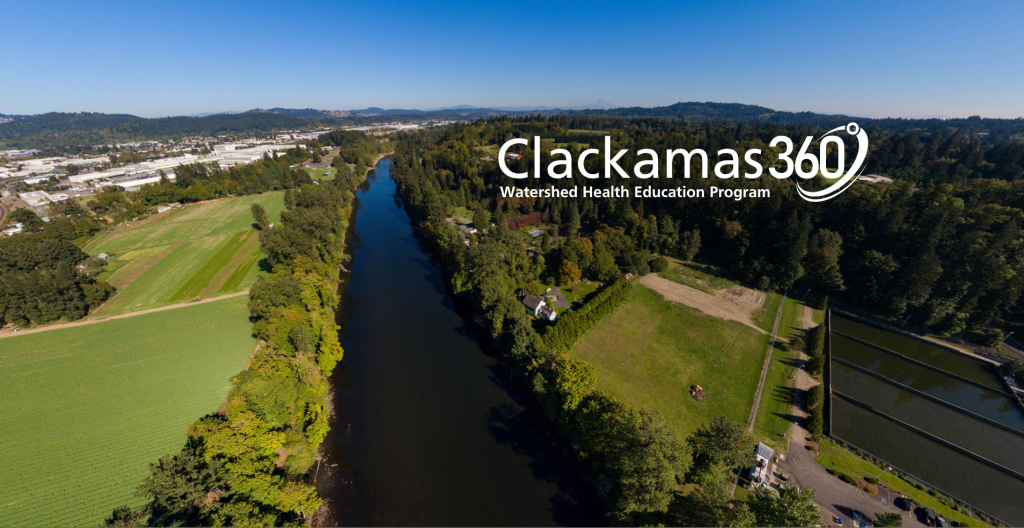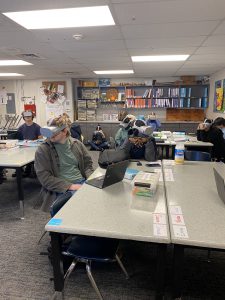
Clackamas360: High School Watershed Health Education for the Classroom and Beyond
Clackamas360 is a free, standards-aligned watershed education program. This two day program offers an in-class virtual reality tour of the Clackamas watershed followed by a field trip for hands-on service learning. All classroom materials, field trip supplies, and bus fees are included.
Local teachers interested in bringing a two-day watershed health experience to their classrooms please email or call us at 503-303-4372 or amy@clackamasriver.org.
About the Program
The Clackamas360 Watershed Health Education Program offer teachers a two-part experience for students;
- An in-person Clackamas360 classroom experience: Our interactive virtual tour takes students on a journey from the headwaters of the Clackamas River to its confluence with the Willamette. Explore key sites with 360-degree imagery, historicl photos, drone footage, and videos that highlight real-world examples of watershed restoration, stormwater management, and salmon recovery.
- A field trip to a local restoration site or streamside location: We offer customized field trip activities that align with the Clackamas360 lessons and deepen students’ understanding through place-based, hands-on learning.

Clackamas360 Classroom Curriculum
The classroom experience consists of two activities; the Clackamas360 virtual tour and a customizable activitiy based on classroom curriculum.
Clackamas360 Virtual Tour: Clackamas360 virtual tour uses Meta Oculus Go headsets to bring students through the lower Clackamas basin using twelve 360-degree drone-captured scenes. Placed throughout these scenes are landmarks, educational graphics, and opportunities to think critically about the scene around them. Voiceover is included which will help guide students through the experience. Each scene in the Clackamas360 Virtual Watershed Tour has a watershed health topic and theme:
- Clackamette Park: Introduction to the Clackamas360
- Willamette Falls: Cultural perspectives
- Timber Forest: What is a watershed?
- Rock Creek: Urban watersheds are all around you
- Riverside Park: Resources from the Clackamas basin
- Eagle Creek Community Forest: Watershed function, “dynamic rivers,” and importance of riparian zones and large wood
- Eagle Creek Falls: Common riparian plants and animals
- North Fork Dam: Watershed stresses
- Carli Creek: Managing stresses with engineered systems
- Eagle Creek at Bonnie Lure State Park: Managing stresses through restoration
- High Rocks Park: What you can do to help
- Upper Clackamas River: Just for fun – two minute whitewater rafting video.
Optional Customizable Activity
- EPA How’s My Waterway Activity – Using the EPA website, students will take a deep dive into the health of a local watershed of their choice and investigate the various water quality indicator categories and their significance.
- Macroinvertebrate activity – Using worksheets created by CRBC, students learn about indicators of watershed health using the ETP index.
- Source water and water quality activity – the Clackamas River is a drinking water source for over 300,000 Oregonians. In this activity students learn about the Clackamas as a drinking water source, why it is important to protect and preserve this source water, and what they can do to help.
- Other options: Geography, botany and native plants, what is a watershed.
Clackamas360 Field Trip Curriculum
The Clackamas360 Field Trip curriculum is based on expanding and reinforcing what was learned about watershed health and water quality in the classroom presentation. The Clackamas River Basin Council is excited to offer the following field trip activities:
- Water Quality Assessment (anytime)
- Tree Planting Stewardship Activity (fall/winter)
- Macroinvertabrate Sampling (anytime)
- Invasive Species Removal (anytime)
- Restoration Project Tours (anytime)
- Habitat Assessments (anytime)
- BioBlitz (spring is best)
Get Started
If you are interested in the Clackamas360 progam, please contact us at 503-303-4372 or amy@clackamasriver.org.
What teachers are saying:
“The 360 tool was very impressive and comprehensive and aligned perfectly (and above and beyond) my curriculum.”
What students are saying: I learned…
“That salmon are a keystone species in our ecosystem and if we continue to take them away from their habitats and if climate change continues they could go extinct in our ecosystem and cause a domino effect to the ecosystem.”
“How salmon are vital to many ecosystems and how salmon have a cultural/spiritual significance to indigenous people.”
“I learned that our watershed in Clackamas is a lot bigger than I thought it was and is very vital for all species to function. I also didn’t know that salmon were keystone species and were that vital.”
“Salmon are the life source of marine derived nitrogen- to help the plants photosynthesize.”
“I learned that both the Salmon named native peoples and the Salmon fish population have been decimated by European and American Colonialism.”
